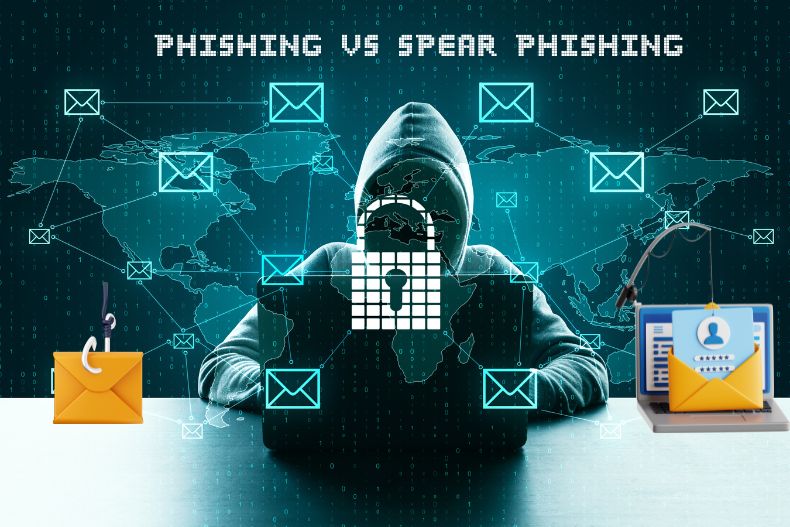If you’ve ever received a suspicious email claiming you’ve won a lottery or need to verify your bank details, you’ve encountered phishing. But what happens when the email is highly personalized, referencing your name, job role, or recent transactions? That’s spear phishing—a much more targeted and dangerous version of phishing.
Understanding the difference between spear phishing vs phishing is crucial for individuals and organizations to protect their data and prevent financial loss. In this article, we’ll break down these two cyber threats, how they work, and how you can defend yourself.

What Is Phishing?
Phishing is a cyberattack method where hackers send fraudulent messages—typically via email, text messages, or phone calls—to trick recipients into revealing personal information. These messages often contain malicious links or attachments that install malware or steal login credentials.
Common Characteristics of Phishing Attacks
- Mass Distribution: Sent to thousands of people at once.
- Generic Messages: Often use vague greetings like “Dear Customer.”
- Sense of Urgency: Fake alerts about account issues or unauthorized transactions.
- Malicious Links or Attachments: Redirect victims to fake login pages.
Types of Phishing Attacks
- Email Phishing – The most common type, involving fake emails from seemingly legitimate sources.
- Smishing (SMS Phishing) – Fraudulent messages sent via text.
- Vishing (Voice Phishing) – Attackers use phone calls to deceive victims.
- Clone Phishing – Hackers replicate a legitimate email but change the links or attachments.
What Is Spear Phishing?
Spear phishing is a more targeted form of phishing. Instead of sending mass emails, attackers carefully research their victims and craft personalized messages to make their deception more convincing. These emails often appear to come from a trusted source, like a boss, coworker, or bank.
Common Characteristics of Spear Phishing Attacks
- Highly Personalized: Includes victim’s name, job title, or recent interactions.
- More Sophisticated: Difficult to distinguish from real emails.
- Targets Specific Individuals or Organizations: Often used in corporate espionage or financial fraud.
How Spear Phishing Works
- Reconnaissance: Attackers gather information from social media, company websites, or past data breaches.
- Email Crafting: The email is tailored to the victim, making it seem genuine.
- Exploitation: The victim clicks a malicious link or downloads an attachment, allowing hackers to steal data.
Key Differences Between Phishing and Spear Phishing
Feature Phishing Spear Phishing
Target General public Specific individuals or organizations
Personalization Generic, uses broad terms Highly customized with personal details
Sophistication Basic scams, easier to spot Advanced, difficult to identify
Attack Volume Mass campaigns Low volume but high success rate
Common Victims Anyone with an email or phone High-value targets like employees, CEOs, or government officials
2024 Cybersecurity Statistics: Phishing and Harmful Emails on the Rise
According to Hornetsecurity’s Cybersecurity Report 2025, over 55.6 billion emails processed in 2024, highlights the following key statistics:
A phishing email might claim that your PayPal account has been compromised and ask you to click a link to verify your details. The link leads to a fake PayPal login page designed to steal your username and password. In 2016, hackers targeted Hillary Clinton’s campaign chairman, John Podesta, with a spear phishing email posing as a security alert from Google. He clicked the fake link, giving attackers access to thousands of confidential emails. ✅ Verify Senders – Always check the sender’s email address for inconsistencies. ✅ Be Wary of Urgent Requests – Scammers often create a sense of urgency to trick victims. Whaling is a type of spear phishing that specifically targets high-level executives or influential figures in an organization. Unlike standard spear phishing, whaling attacks often involve fake legal documents or requests for large financial transactions. Yes, phishing can happen via text messages (smishing), phone calls (vishing), and even fake social media messages. Attackers use multiple channels to trick victims into revealing sensitive information. Organizations can conduct cybersecurity awareness training, run phishing simulation exercises, and implement strict email security policies. Regular testing and education help employees stay alert to phishing threats. Both phishing and spear phishing are serious cyber threats, but spear phishing is more dangerous due to its personalized nature and higher success rate. While phishing relies on casting a wide net, spear phishing focuses on well-researched targets, making it harder to detect and prevent. Understanding spear phishing vs phishing can help you recognize and avoid these attacks. By staying vigilant, verifying suspicious messages, and using cybersecurity best practices, you can protect yourself and your organization from falling victim to these digital scams.
Real-World Examples of Phishing and Spear Phishing Attacks
Phishing Attack Example
Spear Phishing Attack Example
How to Protect Yourself from Phishing and Spear Phishing
General Tips to Avoid Phishing Scams
✅ Don’t Click Suspicious Links – Hover over links before clicking to see the actual URL.
✅ Use Multi-Factor Authentication (MFA) – Even if your password is stolen, MFA can prevent unauthorized access.
✅ Educate Employees and Individuals – Awareness is key in preventing cyber threats.How to Defend Against Spear Phishing Attacks
✅ Limit Information Sharing Online – Attackers use social media to gather personal data.
✅ Use Email Security Software – Advanced filters can detect phishing attempts.
✅ Verify with a Phone Call – If you receive a suspicious email from a known contact, call them to confirm its legitimacy.Frequently Asked Questions FAQs
What is whaling, and how is it different from spear phishing?
Can phishing occur outside of emails?
How can companies train employees to recognize phishing attempts?
Final Thoughts










